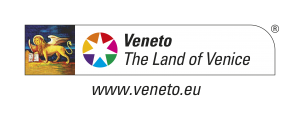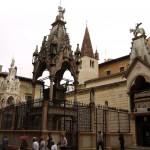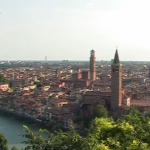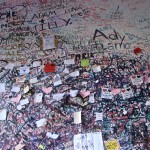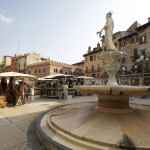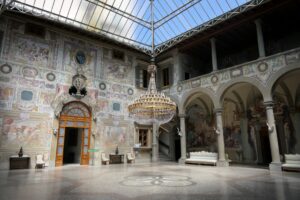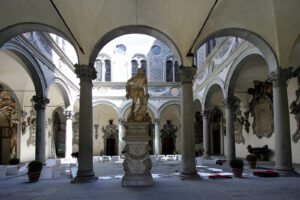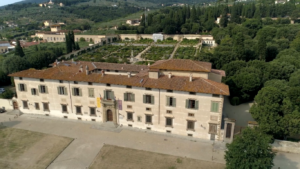Visit the gothic cemetery of Scaliger Family in Piazza dei Signori
Verona: The Ghetto and Via Sottoriva
Two of the most interesting places in Verona
Video full text: Verona, The Ghetto
We are on the opposite side of Piazza delle Erbe. Here too we find some pieces of history. The ghetto was here! The Jewish Quarter began here. These are the only houses that remain of that quarter. That was opened by Napoleon. When he arrived here with his ideals of freedom and equality, he opened the gates of the ghetto that were further on in Via Mazzini. He offered the Jews the possibility of living in any part of the city. The ghetto was about to be destroyed, but it was preserved thanks to the poet, Berto Barbarani, and his friend and painter Angelo Dall’Oca Bianca. They set to work at the start of the 20th century to prevent what was by then a run down district from being destroyed. And so it is that we still have, to this day, the facades of these houses, that were typical of the Jewish ghetto, i.e. tall and narrow, with the access onto the Market Square. This street is via Sottoriva, one of Verona’s most interesting streets. It was and still is the street of the hostelries. “Sottoriva” means that the river Adige is near here. The Adige is just beyond these houses. This is the Adige, our river. Over there is Verona’s first bridge, Ponte Pietra (Bridge of Stone). A Roman bridge. Once upon a time it was made from wood and was repeatedly destroyed by the river. When the Romans founded the city they built it in stone. And they called it Ponte Pietra. Up there is what was once an Austrian barracks, Castel San Pietro. Castel San Pietro? I began my tour from there! I’ve have visited Verona in its entirety! I have seen Verona, I’m really pleased. You haven’t seen Juliet’s house and the Arena yet? Watch the next video then.Produced in cooperation with the Official Tourist Board
Visit Verona: helpful hints
Arrival
For international flights there is the Verona Airport, connected to the city centre by bus (rides every 20 minutes, 6€, it takes 15 minutes). The nearest airport for transcontinental flights is Bologna Airport. From the airport, first you have to reach Bologna Central Station by bus (rides every 15 minutes, it takes 30 minuts, 6€). Then either Trenitalia and Italo trains reach Verona in 50 minutes, prices change according to class and services.Transports
Walking is the best way to visit Verona. Anyway you can move by bus, a single ticket costs 1,3€ and it lasts 90 minutes. For more information check the ATV website.What to do
Verona, the city of love, is in the North Eastern Italy and it is a UNESCO World Heritage Site.
Known wordlwide to be the city of Romeo and Juliet, by William Shakespeare, here you can visit Juliet’s House with the iconic balcony (“O Romeo, Romeo, wherefore art thou Romeo?” – that one). But Verona is famous even more for the Arena di Verona, that is basically the greatest Opera theatre in the world! Check the official website of the Arena for the shows calendar, don’t miss the opportunity to attend a concert sit on this Roman masterpiece (Summer only, of course. No roof, above is only sky, you know). Watch Italia Slow Tour web serie about the city of love.
Last, but not least, Verona is also near the lake Garda, the largest lake in Italy (it takes 30 minutes to Peschiera del Garda or Lazise, 4o minutes to Bardolino, by car).

